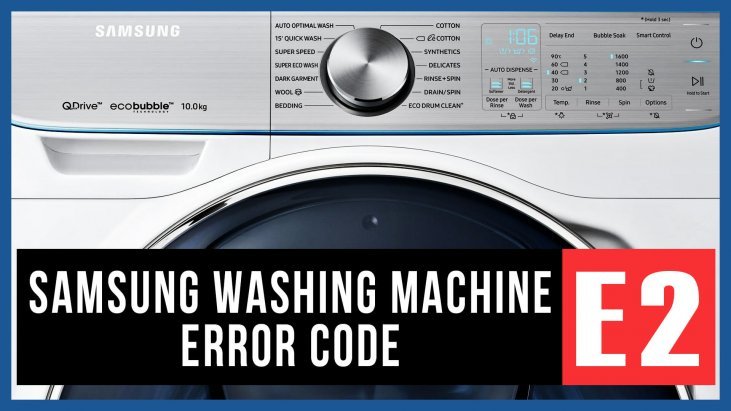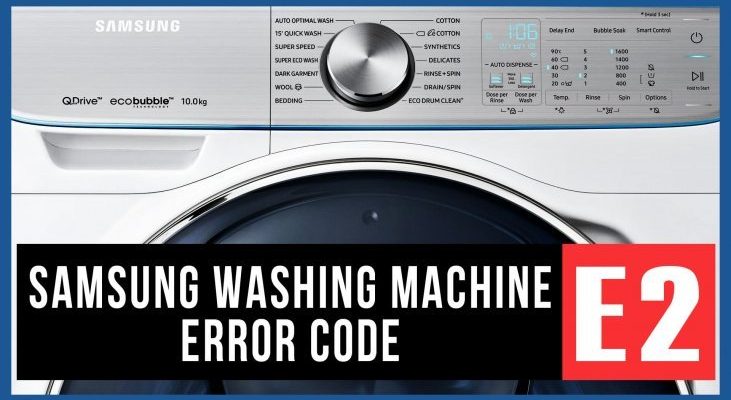
Error Code E2 on a Samsung washing machine essentially indicates a drainage problem. It’s like the laundry equivalent of a traffic jam: water isn’t flowing out as smoothly as it should. This could be due to a variety of reasons, from minor blockages to more serious mechanical issues. You might be thinking, “Can I fix this on my own, or do I need to call in the cavalry?” Let’s dive deeper into this conundrum and see if we can sort it out without having to call a technician — unless it’s absolutely necessary.
Understanding Error Code E2
So, what exactly is this Error Code E2, anyway? Think of it like a distress signal from your washing machine. It’s alerting you that something’s amiss in the drainage department. Imagine a water hose that’s kinked, making it hard for water to flow freely. That’s similar to what might be happening inside your washer.
There are several possible reasons for this error code to appear. Most often, it’s a clogged drain hose or filter. Just like a clogged sink, if there’s a blockage, water can’t escape. Another common issue could be with the pump that’s responsible for moving water out of the machine. If it’s defective, then water is stuck with nowhere to go, triggering the E2 error code you’ve stumbled upon.
While it might be tempting to ignore this issue in hopes it’ll go away, doing so could lead to more significant problems. An inability to drain properly can lead to standing water, which is not just a nuisance but can cause unpleasant odors, mildew, and even damage your clothes. Plus, a malfunctioning washer could be a sign of wear and tear that, left unchecked, might demand more costly repairs down the line.
When To Tackle It Yourself
Before you dash to the phone to call a technician, there are a few things you can try yourself. Just like unclogging a stuck drain in your kitchen, you can attempt to clear any obstructions in your washing machine’s pathway. This might involve checking the drain hose and the drain pump filter, which might be packed with debris or lint.
To get started, ensure your washing machine is turned off and unplugged for safety. Then, take a look at the drain hose at the back of the unit. Is it kinked or bent? Straighten it out and detach it to inspect for clogs. Similarly, check the drain filter, usually found at the bottom front of the machine. Carefully remove and clean it out. Often, a simple rinse under running water does wonders.
If you’re still seeing the E2 error even after cleaning, it might be worth re-examining what’s causing these blockages. Perhaps there’s an issue with the way laundry is loaded or a need for more regular maintenance. These small adjustments can often keep things running smoothly without the need for professional intervention.
When To Call A Technician
Sometimes, despite our best DIY efforts, the problem persists. If you’ve attempted to clear any obvious clogs and your Samsung washer still shows the dreaded E2 code, it may be time to call in an expert. Much like how a leaky faucet might require a plumber, technical issues with the washing machine’s internal components are best handled by professionals.
A technician can delve deeper into the machine’s mechanics than you might be able to at home. They’ll check connections, inspect internal parts like the drain pump itself for faults, and test the machine’s sensors. These are not areas you should tinker with if you don’t have specific training, as doing so could void warranties or potentially cause more harm than good.
Leaving it to a professional ensures that any guarantee on your washing machine is maintained and that the solution is not just temporary but fixes the root cause of the problem. Calling a technician might come with a service fee, but it’s a worthy investment if it means peace of mind and a fully functional washing machine.
Preventative Measures For The Future
Now that you’re aware of the E2 error and its implications, you might be curious about how to prevent it in the future. Much like regular oil changes for your car, routine maintenance can go a long way in avoiding sudden surprises.
Regularly check and clean the drain filter and hose, perhaps every month or two. Consider using smaller loads to ensure your washer isn’t overburdened, which can prevent wear and tear on its components. And don’t forget to occasionally run an empty wash with a cleaner specifically meant for washing machines, which helps to break down any built-up residues.
Keeping an eye on your Samsung washing machine and addressing small issues before they escalate can save you time, money, and frustration. By understanding what Error Code E2 means and knowing when to seek help, you’ll be more equipped to handle laundry day hiccups — turning what seems like a daunting task into a mere bump in the road.
